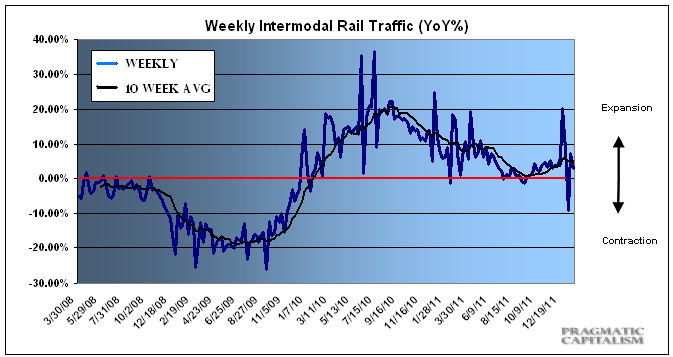Rail data has been all over the map in recent weeks most likely due to seasonal discrepancies. This week’s data settled back towards the 10 week trend with carloads up 1.6% and intermodal traffic up 3%. This is slightly below the 10 week moving average of 5.2%. This is, in my opinion, still consistent with a modestly growing economy and not at all indicative of recession. AAR has the details on this week’s results:
“The Association of American Railroads (AAR) today reported an increase in weekly rail traffic for the week ending January 21, 2012, with U.S. railroads originating 287,734 carloads, up 1.6 percent compared with the same week last year. Intermodal volume for the week totaled 219,706 trailers and containers, up 3 percent compared with the same week last year.
Fourteen of the 20 carload commodity groups posted increases compared with the same week in 2011, with metallic ores, up 50.8 percent; petroleum products, up 26.8 percent, and motor vehicles and equipment, up 16.7 percent. The groups showing a significant decrease in weekly traffic included grain, down 10.7 percent, and farm products excluding grain, down 10.5 percent.
Weekly carload volume on Eastern railroads was down 1.5 percent compared with the same week last year. In the West, weekly carload volume was up 3.6 percent compared with the same week in 2011.
For the first three weeks of 2012, U.S. railroads reported cumulative volume of 861,146 carloads, up 1.1 percent from last year, and 642,609 trailers and containers, up 0.4 percent from last year.”

Mr. Roche is the Founder and Chief Investment Officer of Discipline Funds.Discipline Funds is a low fee financial advisory firm with a focus on helping people be more disciplined with their finances.
He is also the author of Pragmatic Capitalism: What Every Investor Needs to Understand About Money and Finance, Understanding the Modern Monetary System and Understanding Modern Portfolio Construction.

Comments are closed.